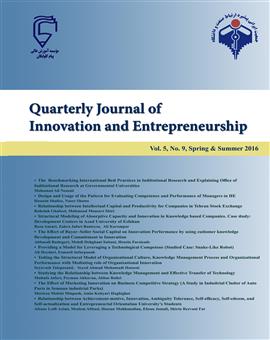design and usage of the pattern for evaluating competence and performance of managers in higher education
Subject Areas :حسین شفیعی 1 * , naser shams 2
1 -
2 -
Keywords: Evaluating the Performance, Competence, Technical University,
Abstract :
There are a several factors for determining the level of organization Success. Among that the performance of managers can play a significant rules to satisfy the customers of organization. Thus, evaluating the perfomance of managers must be used in essential goals every organization. In this article, we review kind of appraisal approach in the different aspects and discuss about one model that involve competence factors for evaluating. Then designing one questionnaire with considering goals of Technical University and collecting data wiht distribution questionnaire. Finally,we analyse and compare the results of this questionnaire and discuss about competence of managers.
1. اکبریان، م، نجفی، ا.ع، عباس، ا (2009). همراستا سازی مدل تعالی کیفیت اروپایی و مدیریت استراتژیک برای رسیدن به بهبود عملکرد. نشریه مدیریت صنعتی, 1(2).
2. فاتح پناه، آ (1386). معرفي الگوي جهاني ارزيابي عملكرد مالكوم بالدريج به همراه ارائه عملي كاربرد آن جهت ارزيابي عملكرد بيمارستان آموزشي هاشمي نژاد شهر تهران بر اساس الگوهاي آموزش و بهداشت - درمان، نشریه طلوع بهداشت، دوره 9، شماره 4.
3. قویدل، ع (1384). مدل تعالی سازمان، منتشر شده در وب سایت پروژه دات کام.
4. بزاز جزایری، ا (2006). رویکرد تی ئی ای ام در ارزیابی عملکرد منابع انسانی، پایگاه علمی مدیریت مقالات، ماهنامه تدبیر، سال هفدهم، شماره 167.
5. فانی، ع، عباسی، ط (2003). بازخور 360 درجه ، پایگاه علمی مدیریت مقالات، ماهنامه تدبیر، سال چهاردهم، شماره 137.
7. قربانیان، م، قوامی، م، مروتی، م (2012). ارائه مدل ریاضی ارزیابی عملکرد مدیران توزیع برق، هفدهمین کنفرانس شبکه های توزیع برق.
8. رضوی، ا.ر، اخوان فرشی، ز، پناهی، م (1393). ارائه مدلی برای بررسی شایستگی مدیران رده بالای سازمان و مقایسه میزان شایستگی با عملکرد آنها، اولین کنفرانس بین المللی اقتصاد، مدیریت، حسابداری و علوم اجتماعی، رشت، خرداد.
.9Tangen, S. (2004). Performance measurement: from philosophy to practice.International journal of productivity and performance management, 53(8), 726-737.
.10Neely, A., Mills, J., Platts, K., Richards, H., Gregory, M., Bourne, M., & Kennerley, M. (2000). Performance measurement system design: developing and testing a process-based approach. International Journal of Operations & Production Management, 20(10), 1119-1145.
.11Yee, C. C., & Chen, Y. Y. (2009). Performance appraisal system using multifactorial evaluation model. Proceedings of World Academy of Science: Engineering & Technology, 41, 231-235.
.12 Espinilla, M., de Andrés, R., Martínez, F. J., & Martínez, L. (2013). A 360-degree performance appraisal model dealing with heterogeneous information and dependent criteria. Information Sciences, 222, 459-471.
.13 Iqbal, M. Z., Akbar, S., & Budhwar, P. (2015). Effectiveness of performance appraisal: An integrated framework. International Journal of Management Reviews, 17(4), 510-533.
.14 Ramaswamy, R., & Chaubey, D. S. (2015). Self Performance Appraisal and its Effectiveness in Performance Management: An Empirical Study in Saudi Arabia. Management Convergence, 5(1&2).
.15Hii, L., & Ahmad, R. (2015). Rater Competency in Conducting Performance Appraisal in the Malaysian Public Sector. International Journal of Social Science and Humanity, 5(1), 69.
.16Lunenburg, F. C. (2012). Performance appraisal: methods and rating errors.International journal of scholarly academic intellectual diversity, 14(1), 1-9.
17. Stevens, G. W. (2013). A critical review of the science and practice of competency modeling. Human Resource Development Review, 12(1), 86-107.
18. Macwan, N., & Sajja, D. P. S. (2013). Performance appraisal using fuzzy evaluation methodology. International Journal of Engineering and Innovative Technology (IJEIT) Volume, 3.

